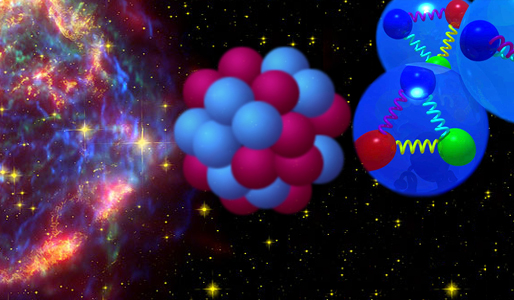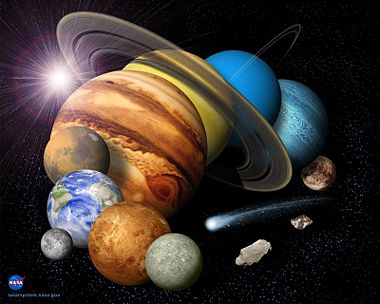Notes 2: Difference between revisions
| Line 85: | Line 85: | ||
'''Extra Terrestrial methods''' | '''Extra Terrestrial methods''' | ||
By observing electromagnetic radiation from the sun we may also determine elemental distributions. This follows the basic premise that each element and chemical compound has its own energy levels and therefore its own unique pattern of absorption and emission lines. One must simply examine the received solar spectra and resolve these patterns to detect these elements and compounds. A complication of this method is that one must have a precise statistical knowledge of how the atoms are ionized and how they interact with photons and other particles | By observing electromagnetic radiation from the sun we may also determine elemental distributions. This follows the basic premise that each element and chemical compound has its own energy levels and therefore its own unique pattern of absorption and emission lines. One must simply examine the received solar spectra and resolve these patterns to detect these elements and compounds. A complication of this method is that one must have a precise statistical knowledge of how the atoms are ionized and how they interact with photons and other particles like atoms and electrons. | ||
Revision as of 12:47, 24 January 2011
Nuclear Astrophysics is a combination of nuclear physics and astrophysics. Nuclear physics is the study of atomic nuclei, their composition and their interactions, while astrophysics aims at studying galactic objects such as stars and galaxies. Nuclear astrophysics delves into the questions of where and when the elements were created and how nuclear reactions drive cosmic events.
The Nucleus
Atomic nuclei sizes are on the scale of meters and form the (relatively) small centers of atoms while carrying most of the mass. The basic constituents of atomic nuclei are protons (Z) and neutrons (N). Protons and neutrons are fermions (particles with half-integral spin, obey Fermi-Dirac statistics, obey the pauli exclusion princile) comprised of three quarks each, fundamental particles on a size scale of . The proton consist of 2 up quarks and one down quark, the neutron consist of two down quarks and one up quark. The up and down quarks have charges +2/3e and -1/3e respectively. The charges of the proton and nuetron (+1, 0) are just the sums of their constituent quarks charges. The relevant interactions on this size/mass scale are the electro-weak and strong forces.
Elements are arranged in the periodic table by order of the atomic number (Z, the number of protons in the nucleus). The atomic mass of an element is A, where A=Z+N. The radius of the nucleus is proportional to the cube root of the mass number
The strong force (SF) (also known as the Nutclear force) is a short range force that dies off after a few femto-meters (3 x 10^-15 m) (in other words, the strong force is only relevant in the nucleus of an atom) and acts on color and charge. It is 100 times stonger than EM but many many orders of magintude stronger than the other 2 forces, gravity and the weak force. The SF mediates interaction between quarks, gluons, and anti-quarks. The gluons are the exchange particles, gluons being spin 1 particles existing only inside hadrons. Hadrons feel the strong force indirectly (or they feel the residual effect of the SF). Hadrons are baryons (made of three quarks, i.e. the proton and neutron) and mesons (a quark and anti-quark pair). The strong force binds nucleons (protons and neutrons) together in the nucleus. It is charge independent, but dependent on spin orientation.
The range of the strong force determined by the uncertainty principle is where m is the mass of the virtual pion.
The weak force acts on flavor. Quarks and leptons experience this force. The W+, W-, and Z0 bosons are the mediating particles. Like the strong force, the stregnth dies off rabpidly with distance.
The electromagnetic force acts on charged particles with the exchange particle being the photon. The Gravitational force works on all mass and energy and is mediated by the graviton.
For every matter particle there is an antimatter particle, denoted with the same symbol but with a bar over it. Antiparticles have the same mass, but have opposite values for electric charge, baryon number, and strangeness.
Definitions for Abundance
The particle abundance of isotope is defined as
where is the the number density of particle , and the sum is taken over all isotopes present. It is also useful to define a relative particle abundance, which is set logarithmically and normalized to the abundance of hydrogen:
The mass fraction is the fraction of total mass in the sample constituted by species :
- ( Note that and )
Denoting the mass per baryon, as
allows us to define the particle's number density by the density of the sample and this baryon fraction,
Another useful quantity is the average mass number, or mean molecular weight, defined by
The electron abundance
- , which can also be written as
is the ratio of protons to nucleons in the sample, and similarly to nuclei, the electron number density is found by
Determining Solar Abundances
It is widely held that the solar system was formed partly from the gravitational collapse of interstellar matter billions of years ago. If so, then a study of the elemental abundances in our solar system should give us a window to what comprised our region of the galaxy at that time. There are several methods of determining the elemental abundances in our solar system.
Terrestrial methods
Examining the materials that we find on earth can yield the desired abundances. However when studying “native” rocks one must be careful in interpreting the data. Through time chemical fractionation would have separated out some of the elements and affected their distribution. However, chemical processes are not dependent on which isotope of the element is involved. Therefore on Earth the distribution of the isotopes within each element should be the same as when the solar system came into existence.
An exception to the chemical fractionation problem is found in the study of a certain class of meteorites called carbonaceous chondrites. About 6% of all meteorites fall into this category. What is significant here is that they appear to have experienced very little heating; therefore they have undergone minimal chemical process and should reflect what the accurate solar system abundances are.
Extra Terrestrial methods
By observing electromagnetic radiation from the sun we may also determine elemental distributions. This follows the basic premise that each element and chemical compound has its own energy levels and therefore its own unique pattern of absorption and emission lines. One must simply examine the received solar spectra and resolve these patterns to detect these elements and compounds. A complication of this method is that one must have a precise statistical knowledge of how the atoms are ionized and how they interact with photons and other particles like atoms and electrons.



















